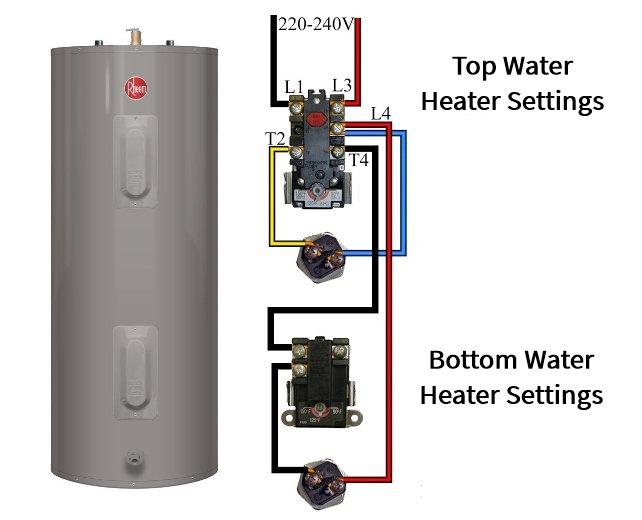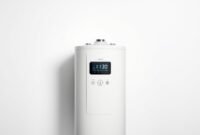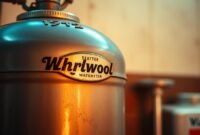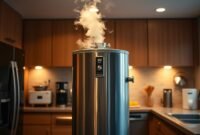Struggling with water temperatures that are never right? Changing your hot water heater settings can help a lot. This guide will show you how to get the perfect water temperature and save energy.
Getting your water heater’s temperature just right is essential. It boosts performance and cuts down on energy use. We’ll dive into the details of hot water heater settings and give you a full guide on temperature control.

Understanding Your Electric Water Heater’s Dual Thermostat System
Electric water heaters use a dual thermostat system for consistent hot water. There are two thermostats, one at the top and one at the bottom. The top one controls the upper heating element, and the bottom one controls the lower one. Knowing how these work together is key for the best performance and energy use.
Read also: How Heating Element Work in a Dishwasher?
The dual thermostat heaters in electric water heaters keep the water hot. You can adjust the top and bottom thermostat settings to change the water temperature. But, setting them wrong can cause uneven heating, lower efficiency, or even damage the thermostats.
The Role of Top and Bottom Elements
The top and bottom elements in a dual thermostat system have different jobs. The top element keeps the water temperature steady. The bottom element adds more heat when needed. Adjusting the bottom thermostat lets you control how much heat is added.
How Dual Thermostats Work Together
The dual thermostats in an electric water heater work together to keep the water hot. The top thermostat controls the upper heating element, keeping the water temperature right. The bottom thermostat controls the lower heating element, adding more heat when it’s needed. By adjusting these settings, you can make your electric water heater work better and keep the water hot.
Safety Precautions Before Adjusting Water Heater Settings
Before you adjust your water heater settings, it’s important to take safety steps. This helps avoid risks. It’s key to prevent overheating and know how to keep your water heater safe.
To prevent overheating, consider these tips:
- Check the temperature and pressure relief valve regularly to ensure it’s working correctly.
- Keep the area around your water heater clear of clutter and flammable materials.
- Set the water heater temperature to a safe level, usually between 120°F and 140°F.
Also, be aware of other safety tips when working with your water heater. Always turn off the power before making changes. If unsure, consider hiring a professional. By following these tips, you can have a safe and efficient water heater.
For more info on water heater safety, check your user manual or call a professional. Remember, safety is always the first thing to consider with gas or electric water heaters.
Optimal Temperature Settings for Different Households
Choosing the right temperature for your water heater depends on several things. The type of household, how much energy you want to save, and the best temperature range are key. For families with kids, a lower temperature helps avoid burns. Adults might prefer a warmer setting for comfort.
Family Homes with Children
For homes with kids, aim for a temperature between 120°F and 140°F. This keeps everyone safe and comfortable. Also, using energy-efficient settings can cut down on bills.
Adult-Only Households
Adults might like their water hotter, between 140°F and 160°F. But, don’t forget to save energy to keep costs down.
Energy-Efficient Temperature Ranges
For saving energy, try these temperature ranges:
- Low: 120°F – 130°F
- Medium: 130°F – 140°F
- High: 140°F – 150°F
These settings can help you save money on bills while keeping your water warm enough.
By picking the right temperature and energy-saving settings, you can make your water heater more efficient. This is true for both gas and electric models. Adjusting the temperature can really help with energy use and comfort at home.
| Household Type | Recommended Temperature Range | Energy-Efficient Settings |
|---|---|---|
| Family Homes with Children | 120°F – 140°F | Low – Medium |
| Adult-Only Households | 140°F – 160°F | Medium – High |
Hot Water Heater Settings Top and Bottom: Step-by-Step Guide
To adjust the top and bottom thermostat settings on your electric water heater, follow these simple steps:
- Locate the thermostat access panels, usually found on the side or front of the water heater.
- Remove the panels to access the thermostat controls.
- Identify the top and bottom thermostat dials or buttons.
- Adjust the top thermostat to your desired temperature, taking into account the optimal temperature settings for your household.
- Adjust the bottom thermostat to a slightly lower temperature to ensure energy efficiency.
Remember to always follow safety precautions when working with electrical appliances. If you’re unsure about how to adjust thermostat settings, consider consulting a professional.
By following these steps and learning how to adjust heater settings, you can optimize your water heater’s performance and save energy.
For more information on top and bottom thermostat settings, consult your water heater’s user manual or contact a professional for assistance.
Accessing Your Water Heater’s Thermostat Panels
To change your water heater’s electric settings, you need to get to the thermostat panels. This step requires care to avoid damage or injury. Make sure you know your water heater’s parts and how to adjust the thermostat before you start.
First, find the access panels on the side or front of your water heater. These panels are for maintenance and adjustments. A thermostat settings guide will help you navigate and adjust the panels easily.
Removing Access Panels Safely
- Turn off the water heater’s power to avoid accidents.
- Wait for the water heater to cool down before removing panels.
- Use a screwdriver to take out the screws holding the panels.
Locating Temperature Controls
After removing the panels, you’ll see the temperature controls and thermostat settings. Take a moment to understand the layout and electric settings. This will help you adjust to your preferred temperature.
By following these steps and using a good thermostat settings guide, you can safely access your water heater’s thermostat panels. Adjust the electric settings as needed. Always be cautious and follow the manufacturer’s instructions for maintenance or adjustments.
The Importance of Balanced Temperature Settings
Keeping your heater at the right temperature is key for good performance and saving energy. Electric water heaters need a balanced setting. This means adjusting the top and bottom heaters to work together well. This way, your water heater works efficiently and effectively.
To get the right temperature, you need to know how to set your water heater. Adjust the thermostat to a temperature that fits your home’s needs. A good starting point is 120°F (49°C), which works for most homes.
Here are some benefits of balanced temperature settings:
- Energy efficiency: Balanced settings can cut down on energy use and lower your bills.
- Optimal performance: The right temperature ensures your water heater works its best, giving you hot water consistently.
- Longer lifespan: Balanced settings can make your water heater last longer by reducing wear on the elements.

By following these tips and understanding the importance of balanced temperature settings, you can make sure your electric water heater works well. It will give you reliable hot water and help you save money on energy bills.
| Temperature Setting | Energy Efficiency | Optimal Performance |
|---|---|---|
| 120°F (49°C) | High | Yes |
| 130°F (54°C) | Medium | Yes |
| 140°F (60°C) | Low | No |
Common Problems with Dual Thermostat Systems
Dual thermostat systems can face issues like uneven heating and temperature changes. A guide on dual thermostats can help you find and fix these problems. It’s key to adjust the thermostat settings right for the best heating.
Uneven Heating Issues
When one thermostat doesn’t work right, heating can be uneven. This leads to water at different temperatures. Adjusting the thermostat settings is vital. A dual thermostat guide can show you how to fix this.
Temperature Fluctuations
Temperature changes can come from bad thermostats or wrong settings. To fix this, you need to adjust the thermostat correctly. Make sure the thermostats are working well.
Thermostat Failure Signs
- Inconsistent water temperatures
- Uneven heating issues
- Increased energy bills
By using a dual thermostat guide and following adjustment tips, your system will work better. Regular checks and fixes can stop common problems. This ensures your heater is at the right temperature.
Energy Savings Through Proper Temperature Management
Managing your water heater’s temperature is key to saving energy. Using energy-efficient settings can cut down your bills and help the planet. For example, setting it to 140 degrees saves energy without sacrificing hot water.
Gas water heaters also benefit from energy-efficient settings. Adjusting the temperature and using smart features can lower your energy use. Here are the main advantages:
- Reduced energy consumption
- Lower energy bills
- Minimized environmental impact
To get the most out of energy-efficient settings, follow these steps:
- Adjust your water heater’s temperature to 140 degrees or lower
- Use features like timers and thermostats
- Keep your water heater in good working order
By taking these steps, you can save energy and help the environment. Always refer to your water heater’s manual for the best way to adjust settings and use energy-saving features.
| Water Heater Type | Energy-Efficient Setting | Benefits |
|---|---|---|
| Electric Water Heater | 140 degree | Reduced energy consumption, lower energy bills |
| Gas Water Heater | Energy-efficient features | Minimized environmental impact, reduced energy consumption |
When to Call a Professional for Thermostat Adjustment
Changing your electric water heater settings is usually easy. But, there are times when you should get help from a pro. If you’re not sure about the right thermostat setting or see odd behavior from your system, it’s time to call an expert. They can make sure your water heater works well and safely.
A bad thermostat can cause water to heat unevenly, raise your energy costs, and even be dangerous. Look out for signs like water not heating right, temperature changes, or not getting hot enough. If you see these, fix it fast to avoid bigger problems.
Signs of Thermostat Malfunction
- Inconsistent water temperatures
- Increased energy bills
- Failure to reach the desired temperature
While you might want to try fixing it yourself, a pro can really help. They can check your water heater, make the right changes, and find problems early. This saves you time and money. Getting a pro to adjust your thermostat means you’ll have a reliable and efficient water heater. Plus, it will last longer.
Seasonal Temperature Adjustments for Efficiency
To make your water heater work better and save energy, adjust the temperature with the seasons. Change the heater settings to fit your home’s needs all year. This way, you use less energy and pay less for utilities.
Here are some tips for adjusting your thermostat:
- Lower the temperature in cold months to save energy and cut down on heat loss.
- In warm months, raise the temperature to meet the higher demand for hot water.
- Think about getting a smart thermostat to change the temperature for you automatically.
When you adjust your electric heater, always follow the maker’s instructions and be safe. Keep an eye on how well your water heater is working and adjust as needed. By following these tips and changing your heater settings with the seasons, you’ll save energy and money. Plus, you’ll always have hot water when you need it.

| Season | Recommended Temperature Setting |
|---|---|
| Winter | 120-140°F (49-60°C) |
| Summer | 100-120°F (38-49°C) |
Conclusion: Maintaining Optimal Water Heater Performance
As we wrap up this guide, it’s clear that managing your hot water heater settings is key. This includes the top and bottom thermostats in electric units. Knowing how your dual thermostat system works helps your water heater run smoothly. It also makes sure your water is always at the right temperature for your home.
Read also: How To: Check Water Heater Anode
Keeping up with maintenance and making adjustments as needed is vital. It helps avoid problems like uneven heating or temperature changes. Follow the steps in this guide to adjust your water heater’s settings safely and correctly.
Whether you live with a family or alone, finding the right temperature settings is important. It makes your home comfortable and saves energy. Optimizing your water heater’s performance means you’ll have hot water when you need it. It also helps the environment and cuts down on utility bills.
Use the knowledge from this dual thermostat guide to improve your water heater’s efficiency. Regular care and watching its performance closely will keep it working well. Your home will have the perfect temperature for years to come.


